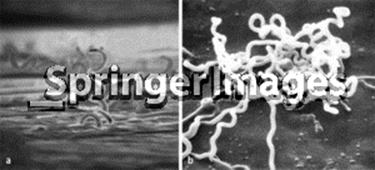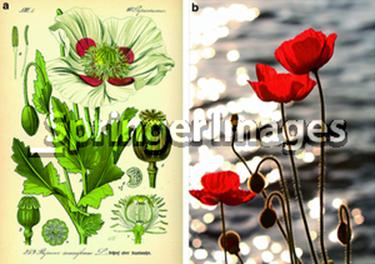I have communicated with Wikip(m)edia over the apparent systematic relicensing and relabeling of their content into “SpringerImages”. It’s fair to say that the individuals I have heard from are seriously upset. The action is clearly a breach of copyright and therefore illegal in most jurisdictions.
The problem is that Wikip(m)edia are not the owners of the content. So they can’t do anything legally.
But they can and should and will (I hope) make a public fuss. They have suggested blogging it (and Wikipedia carries a great deal of public opinion).
So I have:
- Searched http://springerimages.com for “Wikipedia”. This will only give results where the string “Wikipedia” is in the caption, and there are probably >>10 times more than won’t have this. But this gave 350 hits. Therefore I assume there are thousands of Wikipedia images badged as “SpringerImages”.
- Looked for the licensor. In some cases this is not Springer, so I assume it is a publisher which is either owned by Springer or where they have an agreement with Springer. Note that the material taken from Wiley and PLoS is relicensed as Springer’s. I have omitted any material which does not have “Springer” in the licensor.
- Copied the results to this page for the first ten I found.
I have found NO (ZILCH, NADA in Neylon-speak) entries which honour the original licensee. I therefore hypothesize that “ALL your open content are belong to SPRINGER”.
I shall continue.
No doubt Springer will say “terribly sorry, it was a glitch”. It’s a very profitable glitch for them. They resell other people’s content and build up a brand from it. When it goes wrong they can say “sorry”.
For me this is similar to the infamous fake journals published by Elsevier
UPDATE: Daniel Mietchen (Wikimedia/OKFN) has just mailed me http://commons.wikimedia.org/wiki/Category:Images_used_by_media_organizations_but_violating_license_terms – a special page that WP uses for recording violations. It contains the phrase:
“Sometimes, media organizations just don’t understand that in most cases, you just can’t rip an image off Commons and just use it.”
Well, Springer, you had better understand that right now. Because you have spent enough time telling US what we cannot do.
The first ten images: (URL and “Springer” content)
http://www.springerimages.com/Images/Education/1-10.1007_978-1-4419-1551-1_23-0



Caption
Fig 1
A typical 10 inch student slide rule (from Wikipedia Commons – see http://en.wikipedia.org/wiki/Slide_rule )
Viewing this image requires a subscription. If you are a subscriber, please log in.
http://www.springerimages.com/Images/Engineering/1-10.1007_978-3-642-11865-4_22-1



Caption
Fig 2
Pluripotent, embryonic stem cells originate as inner mass cells within a blastocyst. The stem cells can become any tissue in the body, excluding a placenta. Only the morula cells are totipotent, able to become all tissues and a placenta. Image from http://schools-wikipedia.org/images/735/73539.png.htm (Original work by Mike Jones for Wikipedia)
http://www.springerimages.com/Images/Environment/1-10.1007_s11356-010-0315-1-1

Caption
Fig 1
The preserved Vasa in the main hall of Vasa Museum seen from above the bow (source: Wikipedia commons: http://en.wikipedia.org/wiki/File:Vasa_above_bow1.jpg )
http://www.springerimages.com/Images/MedicineAndPublicHealth/1-10.1007_s00194-009-0602-7-1

Caption
Fig 2
a Artifizielle Deformierung eines Inkaschädels (Potosi Décembre 2007 – La Mondea 2; http://de.wikipedia.org/wiki/sch%C3%A4deldeformation vom 11.05.2009; Foto: Martin St-Amant – Wikipedia); b Kinderschädel und -unterkiefer aus Norddeutschland
http://www.springerimages.com/Images/ComputerScience/1-10.1007_978-3-642-18234-1_4-4



Caption
Fig 1
Beispiel für eine Taxonomie: Systematik der Säugetiere (Ausschnitt, vgl. http://de.wikipedia.org/wiki/Systematik_der_Säre )
http://www.springerimages.com/Images/Chemistry/1-10.1007_978-1-4419-6618-6_3-1

Caption
Fig 2
(a) Atrazine formula ( http://en.wikipedia.org/wiki/File:Atrazin.png ) and (b) three-dimensional structure ( http://en.wikipedia.org/wiki/File:Atrazine-3D-balls.png ; courtesy of Benjah-bmm27)
http://www.springerimages.com/Images/Chemistry/1-10.1007_978-1-4419-6618-6_3-2



Caption
Fig 3
Light-dependent reactions of photosynthesis at the thylakoid membrane (created using Powerpoint, based on Taiz and Zeiger, Plant Physiology, 4th edition, ISBN 0-87893-856-7; http://en.wikipedia.org/wiki/File:Thylakoid_membrane.png ; original uploader was Tameeria at en.wikipedia; released into the public domain by the author)
http://www.springerimages.com/Images/MedicineAndPublicHealth/1-10.1007_s00347-008-1900-2-4

Caption
Fig 5
Elektronenmikroskopische Aufnahmen der Spirochaete Treponema pallidum, dem Erreger der Lues. Bilder aus http://de.wikipedia.org/wiki/Treponema_pallidum (a) und http://en.wikipedia.org/wiki/Treponema_pallidum (b)
http://www.springerimages.com/Images/Environment/1-10.1007_978-94-007-2123-4_14-3



Caption
Fig 4
GDP versus fuel prices, countries (Metschies 2005)
Note: Fuel price ( http://www.internationalfuelprices.com ), GDP ( http://en.wikipedia.org/wiki/List_of_countries_by_GDP_(PPP)_per_capita ) Petroleum production ( http://en.wikipedia.org/wiki/Petroleum ); excluding countries with average annual GDP under $2000
http://www.springerimages.com/Images/MedicineAndPublicHealth/1-10.1007_978-1-4614-0170-4_1-0

Caption
Fig 1
The poppy plant as depicted in an old manuscript and as it appears in the field. Opium is derived from the pods and two crops can be grown annually. (a) Left side from: http://en.wikipedia.org/wiki/Opium_poppy . (b) Right side from: http://en.wikipedia.org/wiki/poppy
Consider one likely way this could have happened:
Folks have been submitting articles to springer, using Wikimedia images in them, and during upload have ticked a box saying they were the creator of all images. During this process Springer likely requires you to assign copyright to them. Springer now slightly lazily assumes it owns copyright on the images. No great conspiracy
Yes,
I have considered this and it probably happens. That is why I omitted all content that was obviously from other sources.
But laziness is no defence in law. And Springer are SELLING these. If I appropriate someone’s scholarly image I check. Springer don’t.
It is legally, ethically and morally unacceptable to appropriate people’s materials like this. It is a symptom of the broken publishing system. We should move to a system where all scientific content is freely given and freely re-used.
UPDATE: And this is not a problem of conventional publishing – e.g. where a single image might be misappropriated by a publisher. This is a systematic attempt by Springer to claim ownership of everything submitted to their journals and everything they can find elsewhere (AFAICS). And then to SELL it.
If you are going to do this you have to think through the moral, legal and ethical issues. And this has either not been done or Springer have decided they don’t care about other people’s rights. Yes, it may be laziness, but it’s not morally or legally excusable.
I agree with your central point, but..,
At least one of your illustrative images, the Atrazine formula, is listed at Wikipedia as being in the public domain. As such, it is, I think, fair game for unrestricted reuse.
By contrast, the image of the poppies at Lake Geneva is clearly labeled as CC-BY-SA. That “Share Alike” component of the license ought to limit Springer and others from selling the image (as if it were theirs).
The ethical position of selling public domain images is hard for me to approve, but not technically illegal. The creators of share alike images made it clear that they were sharing, not selling and it definitely is up to Springer and others to do right by them. Springer could probably gain credibility and approval if it published the sharing-licensed works under the license conditions. Wider use is one point of sharing, after all.
Springer, and all publishers, have the responsibility to clear their copyrights just as they expect others to do when republishing Springer’s work.
>>At least one of your illustrative images, the Atrazine formula, is listed at Wikipedia as being in the public domain. As such, it is, I think, fair game for unrestricted reuse.
That is probably true. It may not, of course, apply to all jurisdictions. US government works are Public domain *in the US* I believe. The public domain is non-trivial and vastly abused.
>>By contrast, the image of the poppies at Lake Geneva is clearly labeled as CC-BY-SA. That “Share Alike” component of the license ought to limit Springer and others from selling the image (as if it were theirs).
Exactly.
>>The ethical position of selling public domain images is hard for me to approve, but not technically illegal.
Correct. It is also possible to sell CC-BY works BUT there must be attribution and there must NOT be relicensing. I am perfectly happy (and have said so for years) for people to re-use and resell my code and CC-BY works BUT they must acknowledge me as the copyright owner.
>>The creators of share alike images made it clear that they were sharing, not selling and it definitely is up to Springer and others to do right by them.
Morally yes.
>>Springer could probably gain credibility and approval if it published the sharing-licensed works under the license conditions. Wider use is one point of sharing, after all.
Yes.
>>Springer, and all publishers, have the responsibility to clear their copyrights just as they expect others to do when republishing Springer’s work.
Yes, and to fail to do it on a massive scale is either gross incompetence or gross arrogance.
Is there any sort of enforcement mechanism? Sure one person could track down his or her picture and complain – my guess is Springer would comply immediately. If they didn’t they could be sued. That would be embarrassing, but without much direct cost. Is there any “class action suit” possible? Could Wikimedia do anything other than just give them a list and ask them to remove their copyright claims? probably not.
You can copy the image with their watermark on it (the watermark doesn’t reach the “Threshold of originality”) and put it on the [[Copyfraud]] page on Wikipedia.
Given the lack of an effective enforcement mechanism, I’ll bet that Springer just continues on in the same way. If copyright laws are updated ever again – e.g. to stop “all the blatant copyright infringement by rogue websites” – then we should insist that the protections of the law NOT apply to companies like Springer who blatantly rip off Commons photos.
Thanks Pete
See also http://archiv.twoday.net/stories/97048913/ – I have discussed the Springer Images Topic under the “rubrum” “Der neueste Beschiss” (= the newest bullshit) already in 2009: http://archiv.twoday.net/stories/5814210/
We’re all in agreement that attribution needs to be accurate, and all necessary steps should be taken to correct attribution if it is in error, and that is happening.
Just one quick note of clarification re: Share Alike images though:
“By contrast, the image of the poppies at Lake Geneva is clearly labeled as CC-BY-SA. That “Share Alike” component of the license ought to limit Springer and others from selling the image (as if it were theirs).”
According to the CC website, Share Alike images *can* be included in commercial (paid) collections:
http://wiki.creativecommons.org/Frequently_Asked_Questions#If_I_create_a_collective_work_that_includes_a_work_offered_under_a_CC_license.2C_which_license.28s.29_may_I_choose_for_the_collection.3F
That is why share-alike license comes in two versions, CC-BY-SA and CC-BY-SA-NC
The difference between CC-BY-SA and CC-BY-SA-NC is that with CC-BY-SA a share-alike item can be included in a “collection” which is commercial – but of course doing so does not change the licensing of the original image.
[The Share Alike part of the SA license applies to derivatives or modified versions of the image only.]
Matt
Noted
One further point in relation to the general tone of moral concern over the commercial reuse of CC or public domain content:
Many of us who’ve been involved for over a decade in the open access movement have argued long and hard to persuade publishers not to reserve commercial rights on open access content, but instead to license using the liberal CC-BY license which allows and encourages *all* reuse (both non-commercial and commercial).
It is therefore disheartening to see the suggestion, above, that commercial use of Attribution-licensed or public domain content might be considered “immoral” even if technically allowed.
It would be a great shame if the purpose of Creative Commons, in creating a commons for universal reuse, were to be forgotten.
The commons is not purely for non-commercial purposes, and encouraging/fostering commercial usage (where permitted by the license, as with CC-BY) is a hugely important aspect of the benefit of the commons, not something to be grudgingly tolerated. To give one example, if you buy a printed copy of the works of Shakespeare , or indeed if you buy a ticket to a production of Shakespeare, you are benefiting from the commercial reuse of public domain material. This is a good thing!
In no way does it obstruct or interfere with any non-commercial reuses of the same content (e.g. Project Gutenberg’s free eBook of Shakespeare). But I’m glad to also have the option to buy a commercially printed edition of Shakespeare if I want one.
Matt
Thanks Matt,
>>>]One further point in relation to the general tone of moral concern over the commercial reuse of CC or public domain content:
To be very clear. I am completely in favour of commercial reause
>>>Many of us who’ve been involved for over a decade in the open access movement have argued long and hard to persuade publishers not to reserve commercial rights on open access content, but instead to license using the liberal CC-BY license which allows and encourages *all* reuse (both non-commercial and commercial).
Yes – I have strongly campaigned consistently for CC-BY. I note that the SpringerImages site is universally CC-NC. Maybe this is part of the glitch so I shall not comment till it is changed
>>It is therefore disheartening to see the suggestion, above, that commercial use of Attribution-licensed or public domain content might be considered “immoral” even if technically allowed.
I have NEVER suggested it was immoral. What I suggested was immoral was the transfer of copyright from authors to Springer. This was before we were told that the glitch applied to all content on the site.
>>>It would be a great shame if the purpose of Creative Commons, in creating a commons for universal reuse, were to be forgotten.
>>>The commons is not purely for non-commercial purposes, and encouraging/fostering commercial usage (where permitted by the license, as with CC-BY) is a hugely important aspect of the benefit of the commons, not something to be grudgingly tolerated. To give one example, if you buy a printed copy of the works of Shakespeare , or indeed if you buy a ticket to a production of Shakespeare, you are benefiting from the commercial reuse of public domain material. This is a good thing!
>>>In no way does it obstruct or interfere with any non-commercial reuses of the same content (e.g. Project Gutenberg’s free eBook of Shakespeare). But I’m glad to also have the option to buy a commercially printed edition of Shakespeare if I want one.
Either you have seriously misinterpreted me or your concern is with someone else.
I should note that until the glitch is fixed people are still being charged for content that should be free. I think it’s imperative that the website should announce that some of the content on the site is misrepresented
Matt